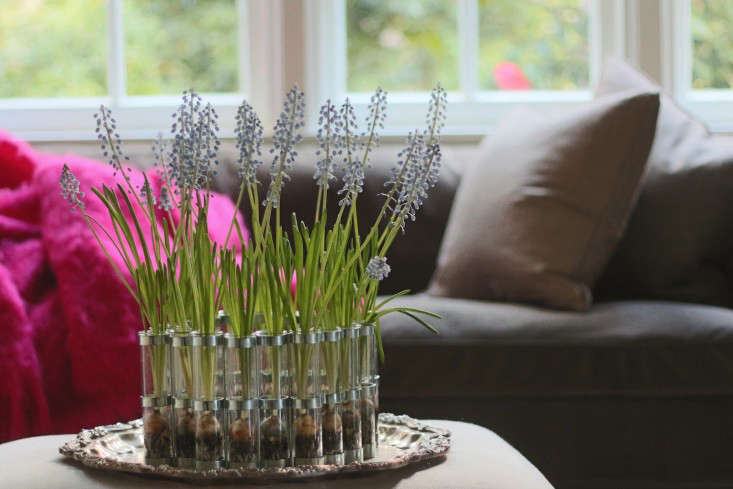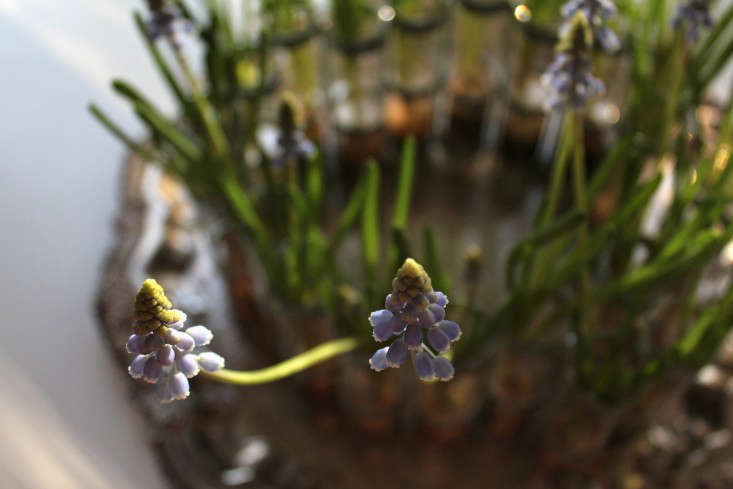You can keep your paperwhites. Yes, I know they’re foolproof to force. But to me, grape hyacinths mean spring. So this year I decided to pass on the no-brainer bulbs to instead see just how hard it would be to force (or should I say strongly encourage?) muscari to bloom indoors.
For materials and step-by-step instructions, see below:
Photographs by Michelle Slatalla.

Above: The trick to getting muscari bulbs to bloom is to persuade them that spring has arrived after they’ve endured a long, cold winter. For this to work, you have to put them in a cool, dark place to simulate winter. My plan was to keep them captive in the bottom drawer of the refrigerator for eight weeks, and then parole them to sunlight and warmth. As you can see…they fell for it.
Above: I decided to force the bulbs in my favorite April Vase; €161.67 from Tsé & Tsé. It consists of 21 linked test tubes that you can bend into a variety of shapes–an “S” snaking down the middle of the table, for instance, or a circle, or a straight line on the windowsill.
Muscari flowers get leggy; a tall, narrow vase that holds each bulb snugly in the bottom will prevent leaves from flopping before flowers bloom.

Above: In addition to a vase, you’ll need a few other materials.
Materials:
- Bulbs; I used Muscari Ocean Magic from Longfield Garden (the variety is available seasonally). You can also use other varieties of grape hyacinths (or tulips or paperwhites or hyacinths, if you insist).
- Pebbles
- Potting Soil
- Florists’ moss, such as Terrarium Moss ($19.95 from Moss Acres)
- A teaspoon
- A brown paper grocery bag, cut open to form a flat panel

Above: Bulbs do not like to sit in standing water; they rot if that happens. When forcing them, the goal is to create a well-drained nest to coax a bulb to send down roots to reach the water beneath it.
Step 1: Using a spoon or terrarium tools, add a 1- or 2-inch layer of pebbles to the bottom of the vase. This will aid drainage.
Step 2: Add a spoonful of potting soil on top of the pebbles and then cover with a small cushion of moss.
Step 3: Moisten the moss with from 2 to 4 teaspoons of water, depending on the size of the vase. The goal here is to use enough water to wet the moss and the potting soil and to collect at the bottom of the drainage layer; the moisture will lure the roots to grow downward to get water.

Step 4: Place each bulb with roots down (and crown up) on top of the moss cushion.
Step 5: Open the bottom drawer of the refrigerator. Remove all the stray, wilted stalks of celery and soft, sad carrots and potatoes that have sprouted accusing eyes. Now you have plenty of room to place your vase in the drawer. Cover the vase with the flat brown paper bag (to block light). Close the refrigerator drawer–and don’t open it again for eight weeks.
N.B.: Would you prefer to force a single, larger bulb in a vase of water? See 10 Easy Pieces: Vases to Force Bulbs.

Step 6: After eight weeks, you should see tiny green shoots starting to grow from the top of the bulbs’ crowns. Place the vase in a sunny, warm spot.
Step 7: Give each bulb a teaspoon or two of water every two or three days–just enough to moisten the moss and the soil. But do not allow the bulbs to sit in standing water.

Above: Within a week of coming out of the refrigerator, my bulbs had 6-inch leaves.

Above: I started to see stalks with small purple clusters of flowers growing up through the center of the leaves.

Above: My muscari flowers were still going strong three weeks after coming out of the refrigerator.

Above: What’s next for these little guys? Stay tuned: I am going to experiment with making my own pressed botanical specimens.
Want to force something that’s a little more foolproof? See DIY: Bottle-Fed Paperwhites.













Have a Question or Comment About This Post?
Join the conversation